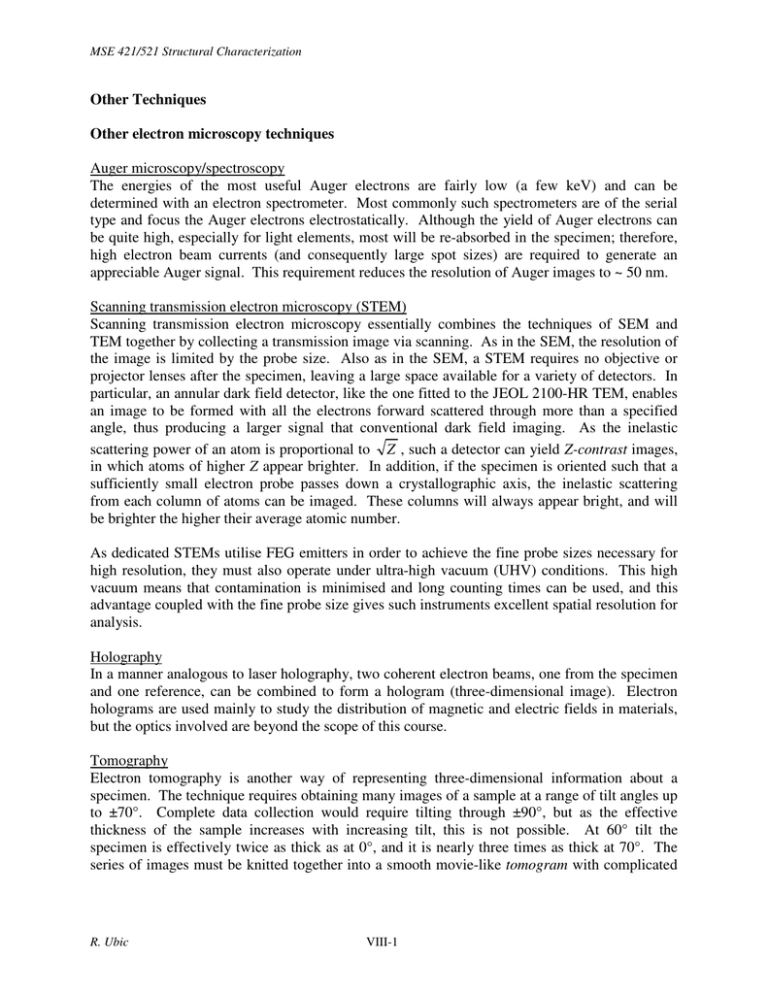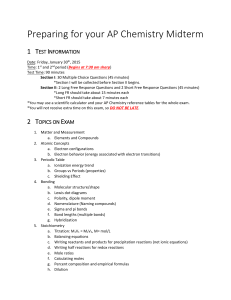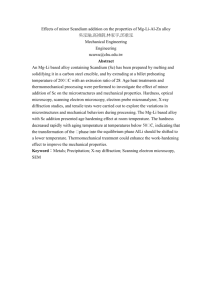Other Techniques Other electron microscopy techniques Auger microscopy/spectroscopy
advertisement

MSE 421/521 Structural Characterization Other Techniques Other electron microscopy techniques Auger microscopy/spectroscopy The energies of the most useful Auger electrons are fairly low (a few keV) and can be determined with an electron spectrometer. Most commonly such spectrometers are of the serial type and focus the Auger electrons electrostatically. Although the yield of Auger electrons can be quite high, especially for light elements, most will be re-absorbed in the specimen; therefore, high electron beam currents (and consequently large spot sizes) are required to generate an appreciable Auger signal. This requirement reduces the resolution of Auger images to ~ 50 nm. Scanning transmission electron microscopy (STEM) Scanning transmission electron microscopy essentially combines the techniques of SEM and TEM together by collecting a transmission image via scanning. As in the SEM, the resolution of the image is limited by the probe size. Also as in the SEM, a STEM requires no objective or projector lenses after the specimen, leaving a large space available for a variety of detectors. In particular, an annular dark field detector, like the one fitted to the JEOL 2100-HR TEM, enables an image to be formed with all the electrons forward scattered through more than a specified angle, thus producing a larger signal that conventional dark field imaging. As the inelastic scattering power of an atom is proportional to Z , such a detector can yield Z-contrast images, in which atoms of higher Z appear brighter. In addition, if the specimen is oriented such that a sufficiently small electron probe passes down a crystallographic axis, the inelastic scattering from each column of atoms can be imaged. These columns will always appear bright, and will be brighter the higher their average atomic number. As dedicated STEMs utilise FEG emitters in order to achieve the fine probe sizes necessary for high resolution, they must also operate under ultra-high vacuum (UHV) conditions. This high vacuum means that contamination is minimised and long counting times can be used, and this advantage coupled with the fine probe size gives such instruments excellent spatial resolution for analysis. Holography In a manner analogous to laser holography, two coherent electron beams, one from the specimen and one reference, can be combined to form a hologram (three-dimensional image). Electron holograms are used mainly to study the distribution of magnetic and electric fields in materials, but the optics involved are beyond the scope of this course. Tomography Electron tomography is another way of representing three-dimensional information about a specimen. The technique requires obtaining many images of a sample at a range of tilt angles up to ±70°. Complete data collection would require tilting through ±90°, but as the effective thickness of the sample increases with increasing tilt, this is not possible. At 60° tilt the specimen is effectively twice as thick as at 0°, and it is nearly three times as thick at 70°. The series of images must be knitted together into a smooth movie-like tomogram with complicated R. Ubic VIII-1 MSE 421/521 Structural Characterization alignment software utilising either a fiducial (marker) or cross-correlation (non-marker) technique. RHEED and LEED Both reflection high-energy electron diffraction (RHEED) and low energy electron diffraction (LEED) are used to reduce the depth from which diffraction information is obtained. In RHEED this is achieved by directing the primary beam at a very low glancing angle of incidence with respect to the specimen. In LEED, the same is achieved by normal incidence but reducing the voltage (energy) of the primary beam, thus limiting its penetration into the specimen. Both techniques can be used to obtain extremely detailed surface structural information. Scanning probe microscopy Scanning tunneling microscopy (STM) STM relies on quantum mechanical tunnelling. The electron distribution of a solid conductor extends slightly into free space. If two such conductors are brought close enough together that their distributions overlap, they essentially become like one conductor rather than two and a current (the tunnelling current) can flow between them if a voltage is applied. The magnitude of this current is extremely sensitive to the spacing between the conductors, and it is this current which is measured in STM. A probe with a very sharp point is scanned across a surface. As the height of the surface changes, the tunnelling current changes and a feedback mechanism adjusts the height of the probe. In this type of electron microscope there is no primary beam, no secondary effects, and no lenses. With an STM it is possible to see the surface crystallography of a sample. The probe need not be atomically sharp, as only its most protruding atom will be brought to within tunnelling distance of the specimen. Piezoelectric controls are used for the fine positioning of the probe, and due to the very tiny distances between the probe and the sample, great care must be taken against vibrations in the lab. Atomic force microscopy (AFM) An AFM is similar to an STM except that in an AFM the probe is mounted on a cantilever and kept a constant distance from the surface of the specimen by the interatomic forces (the outer electrons in the atoms of both the probe and specimen repel each other). While the probe is scanned across the sample surface, its vertical displacement is measured using a laser which reflects off the cantilever onto a position-sensitive detector. Deflections of less than 1 Å can be measured in this way, giving AFM atomic resolution in three dimensions. Magnetic force microscopy (MFM) is a variant of AFM in which the dominant force between probe and specimen is magnetic. Magnetic domain structures can be studied in this way. Field ion microscopy Although the TEM has occasionally been used in high-resolution mode to image vacancies either singly or in networks, and Z-contrast in STEM mode can almost do the same, it is not generally possible to image single point defects in the TEM. The field ion microscope (FIM) allows some R. Ubic VIII-2 MSE 421/521 Structural Characterization individual atoms and point defects to be imaged in conducting or semiconducting samples. In this technique, the sample is prepared as a fine point with a radius, r, less than 1 µm (but typically <50 nm) and cooled to 20 - 100 K. A high potential of up to 10 kV is applied between the sample and a screen a distance R away. A low pressure of inert gas like He or Ne is maintained in the space between the sample and the screen, and atoms adsorbed on the sample are ionised by the strong electric field near the sample tip and are accelerated towards the screen. The curvature of the sample tip causes natural magnification, which is simply equal to R/r. The atom probe field ion microscope (APFIM) is an extension of this technique which combines time-of-flight spectroscopy with field ion microscopy to produce three-dimensional reconstructions of up to hundreds of millions of atoms. In this technique, a high-frequency voltage is applied to a FIM sample tip (or a laser is pulsed), ionizing a whole layer of surface atoms and stripping them from the sample. Instead of arriving on a screen, the ions travel through an aperture (probe hole) towards a detector. A fast timing circuit is used to measure the time taken between the pulse and the impact of the ion on the detector, thus allowing the massto-charge ratio of the ion to be calculated and the corresponding element to be identified. Ion beam analysis Secondary ion mass spectroscopy (SIMS) In this technique, a beam of ions (about 20nm in diameter, typically argon) is scanned across the sample surface and ejects secondary ions in a process similar to ion beam thinning. The chargeto-mass ratio of the secondary ions can be determined by a mass spectrometer. At low beam currents (static SIMS), less than a full monolayer can be detected. At higher beam currents (dynamic SIMS), depth profiling can be done as each successive layer of atoms can be analysed as it is removed. Unlike EDS or WDS techniques, SIMS is sensitive to even the light elements and is isotope specific. Ions generally penetrate the sample much less deeply than electrons of similar energies, so they are more surface-sensitive. Also, the signal-to-noise ratio for secondary effects excited by ions is larger than that for electrons, so the sensitivity of ion-based techniques is better. SIMS is the most sensitive surface analysis technique and can typically detect elements present in the ppm range and sometimes even the ppb range. On the other hand, the spatial resolution of ion techniques (< 1 µm) is worse than for electron probes. Rutherford Backscattering (RBS) In RBS, He2+ ions of 1.5 - 3 MeV are directed at the specimen. Some of these ions are backscattered through an angle greater than 90°. These ions lose a well-defined amount of energy in their Rutherford (backscattering) collision and more by interactions during their passage through the specimen; therefore, a spectrum of these energies allows both the identification of these atoms (to within ppm concentrations) as well as their depth distribution with a spatial resolution of about 10 nm. For single-crystal samples, the ion beam can be oriented in such a way as to channel along particular crystallographic directions. In this condition RBS is even more sensitive to imperfections which locally modify the crystallinity. R. Ubic VIII-3 MSE 421/521 Structural Characterization X-Ray photoelectron spectroscopy (XPS) Another name for this technique is electron spectroscopy for chemical analysis (ESCA). X-ray or ultraviolet photons are used to excite photoelectrons whose energies carry information about the binding energy within the original atoms, and thus about the nature of the atoms in the specimen. The characteristic kinetic energy of the photoelectron is given by the energy of the incident x-ray or ultraviolet photon, which is totally absorbed, minus the characteristic binding energy of the electron which is emitted. Since photoelectrons can only escape from near the specimen surface, the chemical information which they carry is specific to the top few atomic layers. XPS is therefore a specialist technique for surface analysis (together with Auger electron spectroscopy). Photoelectron energies are also sensitive to the state of bonding of the atom from which they come (unlike, e.g., x-rays in EDS), so, for instance, metallic iron can be distinguished from iron in an oxide. Unfortunately, because the incident x-rays cannot easily be focused and inevitably excite a relatively large area of the specimen (100µm2), XPS does not offer high spatial resolution. Ultrahigh vacuum conditions are also required throughout the instrument to prevent contamination of the specimen surface. The XPS spectrum can be broken down (de-convoluted) into individual peaks, each representing a different electron state. In this example of Ti, there are four different electron states with different binding energies, two for Ti bound to O and two for Ti bound to N. Note the high sensitivity of the technique to binding energy – the whole graph only covers a range of 16eV. This level of sensitivity is needed to reveal chemical shifts in binding energies and hence local atom environments. Confocal microscopy A limitation of conventional light microscopy is the very narrow depth of field. In a confocal microscope, this narrow depth of field is used to advantage in order to obtain three-dimensional information from transparent samples. In such an instrument, a narrow objective aperture is used R. Ubic VIII-4 MSE 421/521 Structural Characterization to exclude light from all but the in-focus region of the specimen, and as only one point can ever be truly confocal at a time, a laser is scanned across the sample whilst the computer-controlled aperture and lens move correspondingly to obtain data in three dimensions, which is then stored on a computer for later viewing. Confocal microscopy is used mainly by biologists and materials scientists who require the resolution of light microscopy and cannot put their samples into the vacuum of an SEM. R. Ubic VIII-5







